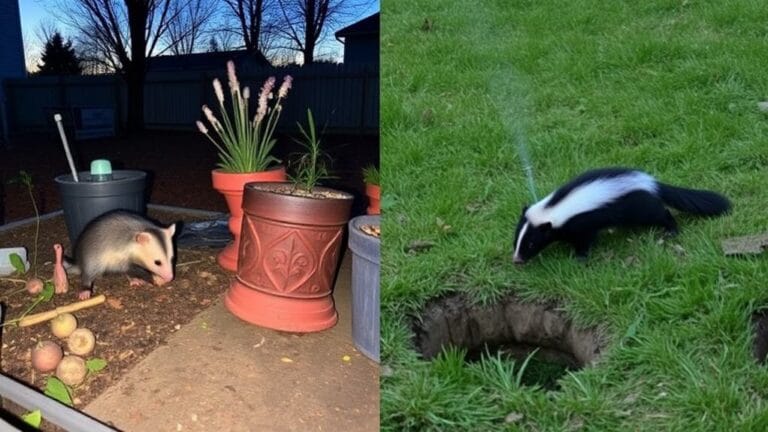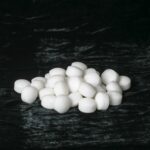If you're hearing noises up there, knowing whether it's possums or rats can save you major headaches. Possums make heavy thumping sounds and hiss, while rats create lighter scratching and squeaking noises. Your unwanted roommates also leave different calling cards – possums tear up insulation and nest in one spot, while rats gnaw through everything (including electrical wires – yikes!) and build multiple nests. Size matters too – possums need bigger entry points (1.5 inches) compared to rats (just 0.25 inches). Both are nocturnal troublemakers, but I've got plenty more ways to tell these pests apart.
Signs and Sound Patterns
Table of Contents
During nighttime hours, you can distinguish between possums and rats in your attic by their distinct sound patterns and behaviors.
These nocturnal animals might be driving you crazy, but knowing what you're dealing with is essential before you start plotting their eviction. Unlike nesting tree squirrels that prefer heights of at least six meters, both possums and rats will readily take up residence in your attic spaces.
Listen carefully – I'm talking detective work here. Possums are the clumsy teenagers of attic dwellers. They'll give themselves away with heavy thumping and occasional hisses.
Rats? They're more like tiny ninjas with their quick pitter-patter and squeaking sounds.
Pro Tip: Don't confuse baby raccoons with either species – they've their own distinct crying sound.
Your cheat sheet for identifying the animal:
- Possums: Heavy footsteps, grunting, scampering
- Rats: Light scratching sounds, chirps, wall-running
- Vocalizations: Possum hisses vs rat squeaks
Trust me – as common animal intruders go, you'll want to know which is which.
Damage and Destruction Differences
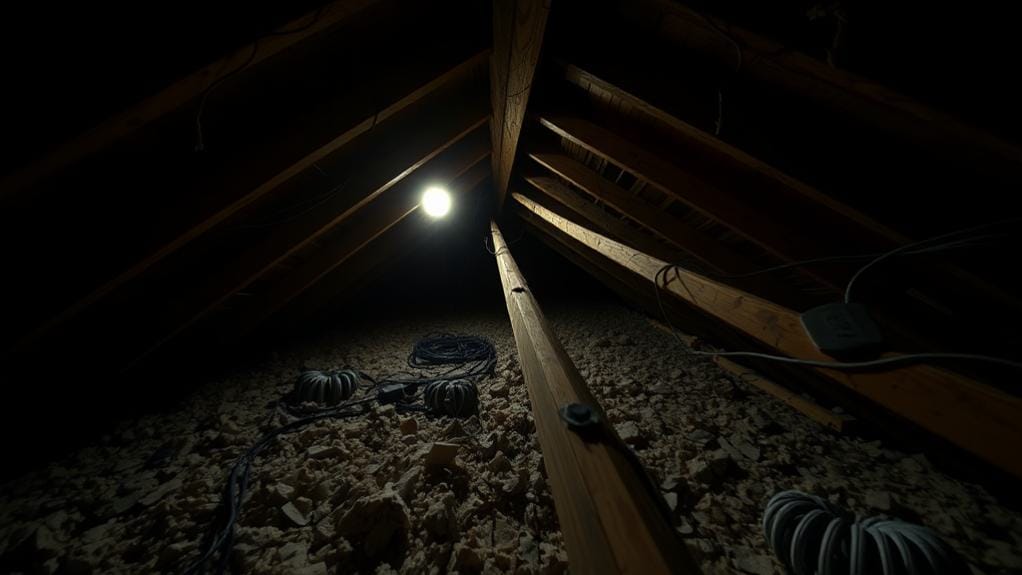
A homeowner's worst nightmare unfolds differently when comparing possum and rat infestations in your attic.
Let me break down the damage and destruction differences so you'll know exactly what you're dealing with.
Think you've got an animal in the attic? Here's the deal – rats or mice will absolutely wreck your home.
They'll chew through everything: electrical wires (hello, fire hazard!), plumbing, and insulation to use for their cozy little nests.
Regular inspections reveal that rodents often attract dangerous parasites like fleas and ticks that can spread disease to humans.
You're looking at thousands in repairs.
Possums? They're more like messy houseguests.
Sure, they'll tear up your insulation and leave behind nesting material, but they won't create new entry points by chomping through your walls.
Their weak bite means less structural damage.
But don't get too comfortable – their nests can attract other unwanted critters to your attic party.
Entry Points and Access Methods
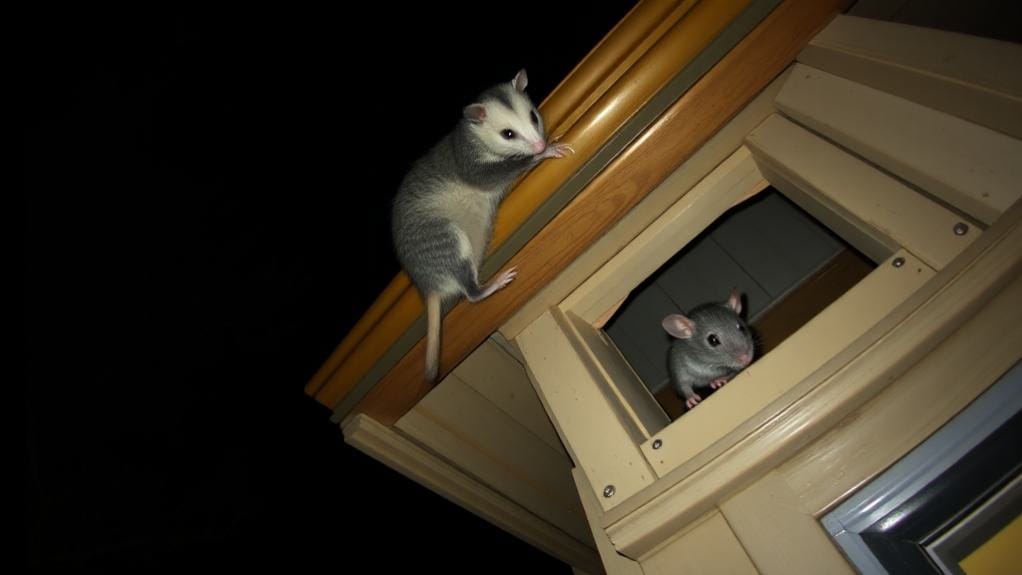
Now that you know what damage to expect, let's look at how these unwanted guests get into your attic in the first place. You'd be shocked at how these little acrobats access your home – and yes, I'm talking about both possums and rats.
| Entry Point | Possums vs Rats |
|---|---|
| Size Needed | 1.5" vs 0.25" |
| Common Access | Roof gaps vs Foundation holes |
| Climbing Method | Trees/powerlines vs Pipes/wires |
| Entry Style | Squeezing vs Gnawing |
| Warning Signs | Heavy scratching vs Light scratching |
Trust me – if you're hearing noises up there, don't wait to call wildlife removal. Both creatures are masters at finding ways in. While possums prefer using their climbing skills to reach high entry points, rats will chew through anything – including electrical wires – to create new access methods. *Pro tip: Check your roof monthly for potential entry points. These critters are probably better at spotting them than you are!*
Nesting and Living Habits
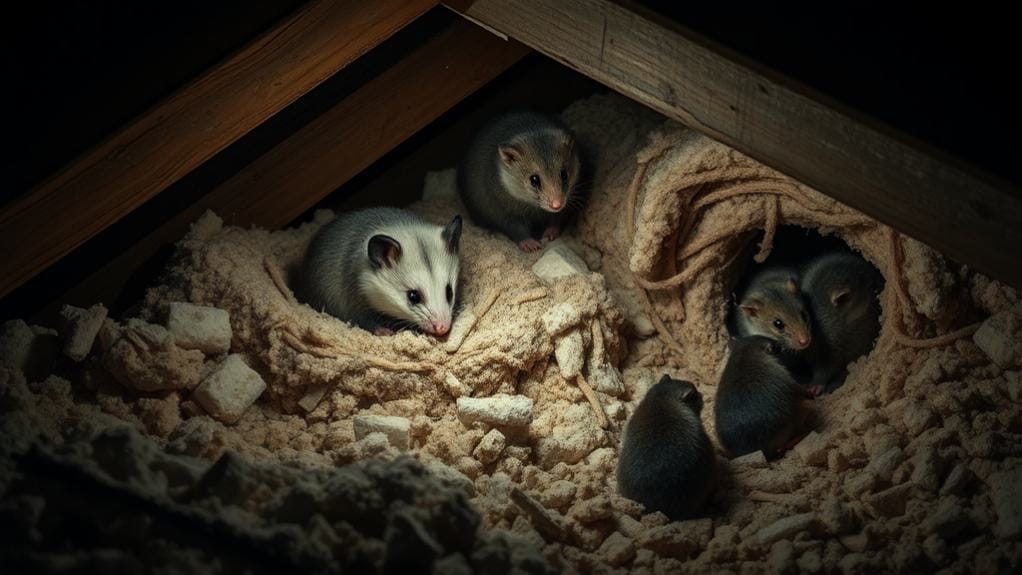
Masters of home invasion, possums and rats exhibit strikingly different nesting behaviors once they've settled into your attic. When these unwanted guests enter your home, you'll quickly notice their distinct habits.
While a solitary possum will claim one cozy corner with leaves and grass, rats are social creatures that'll throw multiple house parties across your attic. Unlike rats, slender scavengers prefer a simple lifestyle and typically weigh between 5-14 pounds, making their nesting areas easier to identify.
I've seen how rats love creating elaborate nests from whatever they can shred – your insulation, important papers, or that Christmas sweater you stored away. They're not picky!
Meanwhile, possums keep it simple with one main crash pad. But here's the kicker: rats multiply fast and build nesting sites everywhere, while possums stick to their favorite spot like homebodies.
Trust me, you don't want either making themselves comfortable up there.
Activity Times and Seasonal Behaviors
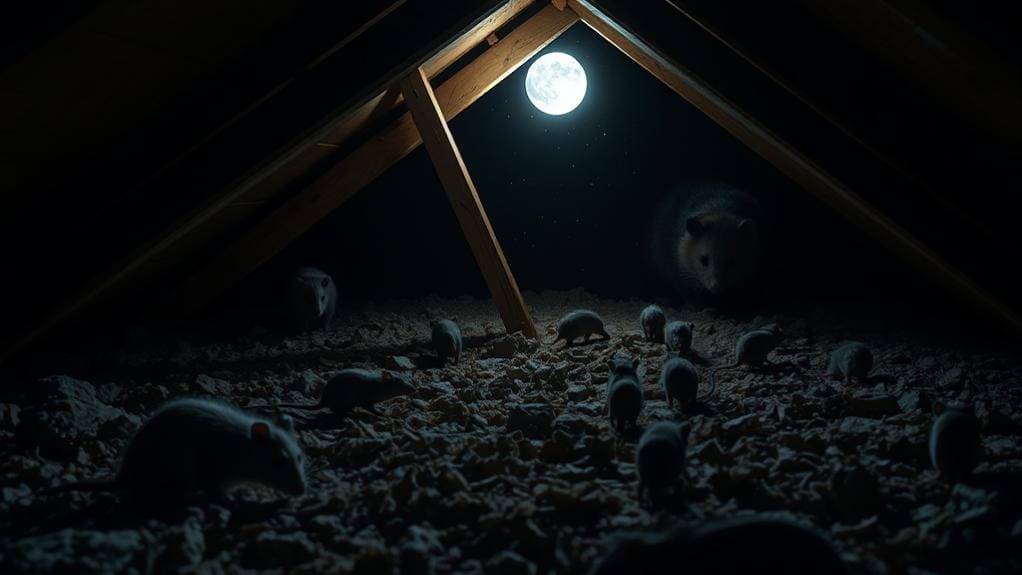
Living patterns of possums and rats swing into high gear after dark, though their behaviors differ markedly throughout the year. If you're hearing nocturnal scurrying or scratching, you've got some midnight partiers up there!
Natural pest control makes possums valuable visitors, as they hunt rodents and insects during their nightly rounds. Possums typically enter buildings during winter months (because who doesn't want free heating?) and give birth twice annually – expect baby drama in late summer and winter.
Rats, those overachieving pests, breed year-round and really ramp up their activity times when it's cold outside.
Pro tip: Pay attention to seasonal behaviors! If you're hearing movement in spring and early summer, you might've raccoons crashing the party too.
Here's the kicker – both critters love your cozy attic, but rats are the more persistent houseguests. They'll stick around all year if you let them.
Health Risks and Safety Concerns
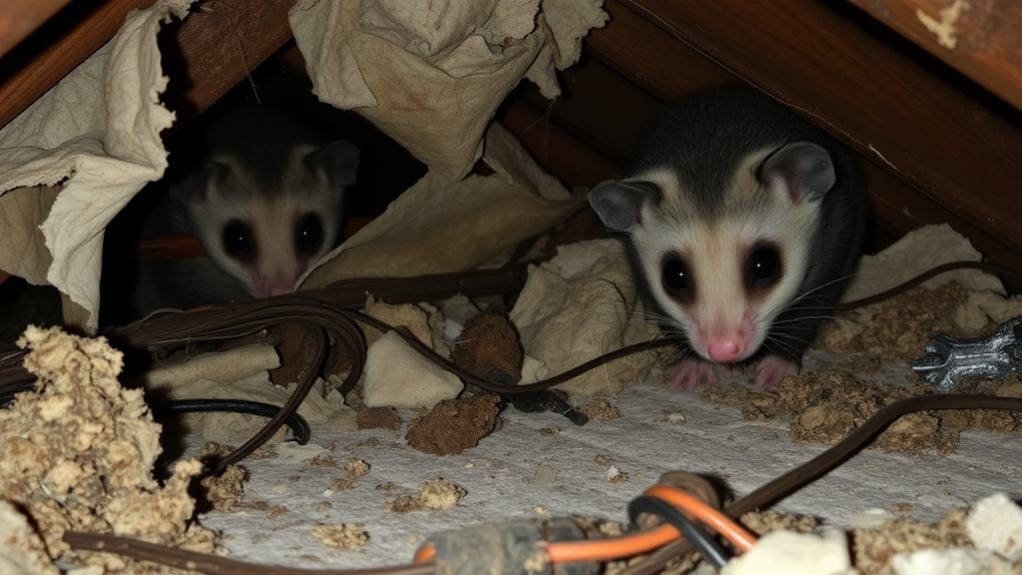
Three major health hazards lurk when possums and rats take up residence in your attic.
Let's face it – your attic isn't meant to be a safe place to give these critters a cozy home while they spread diseases and create health risks for your family.
Disease carriers like possums can be particularly concerning due to the multiple dangerous illnesses they may transmit to humans.
Here's what you're dealing with when these unwanted guests move in:
- Nasty droppings that trigger allergies and respiratory problems (bonus: that musky smell won't quit)
- Disease transmission through parasites like fleas and ticks
- Contaminated areas from urine that'll make your nose wrinkle
- Fire hazards from their tendency to gnaw on wood and electrical wiring
*Pro tip: Don't play superhero – call pest control immediately if you spot signs of these invaders. Trust me, your lungs (and nose) will thank you later.*
Effective Control and Prevention Strategies
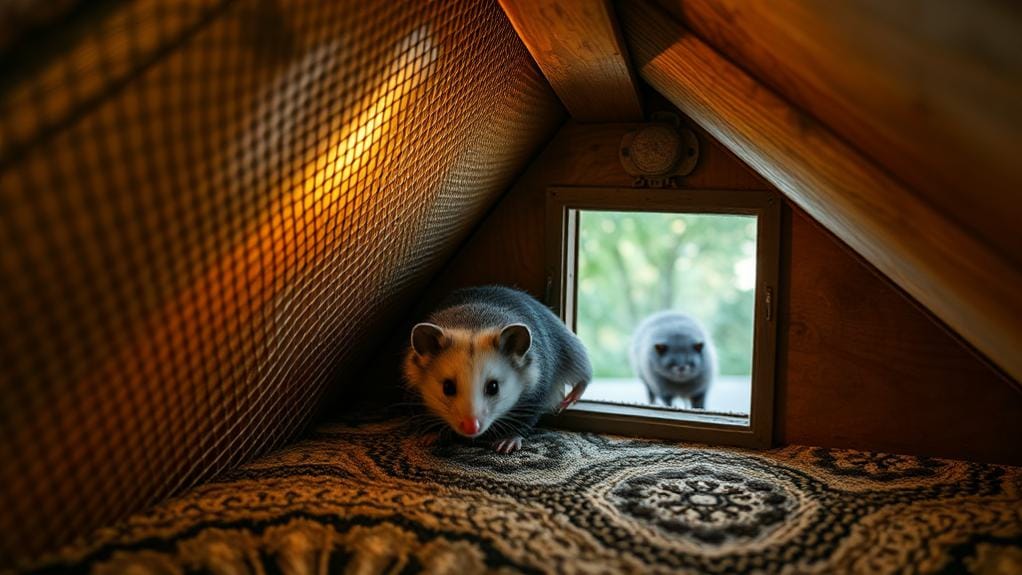
Keeping those unwanted attic guests out starts with a smart prevention strategy, not just dealing with them after they've moved in.
Let's face it – nobody wants to play landlord to furry squatters destroying their insulation.
Start with regular attic inspections to identify entry points. I'm talking about a thorough sweep – every nook, every suspicious gap needs your attention.
Sealing entry points is vital for long-term possum prevention and needs immediate attention once discovered.
Here's your action plan:
- Install metal mesh over any openings larger than 1.5 inches (because apparently that's all a determined critter needs)
- Keep your attic clean and clutter-free (shocking concept, I know)
- Get those tree branches away from your roof
- Add vent covers and chimney caps
Pro Tip: *Prevention is way cheaper than control measures after they've moved in. Trust me on this one – I've seen the repair bills.*
Frequently Asked Questions
How Do I Know if It's a Rat or Possum?
I'll help you identify which pest you have: look for larger oval droppings and musky smells for possums, while rats leave rice-sized droppings and gnaw marks. Check footprints too – possums have opposable thumbs.
What Does a Possum in the Attic Sound Like?
I'll tell you what possums sound like up there: you'll hear heavy, slow thumping and shuffling at night, plus some distinct grunts, hisses, and screeches. The noises are much louder than rat sounds.
How to Tell if You Have a Possum in Your Attic?
I'd listen for nighttime scratching and scampering sounds, plus look for their distinct 2-inch droppings. You'll also notice a musky smell and might find nests made of leaves in your attic's corners.
What Does a Rat in the Ceiling Sound Like?
I'll tell you – it's like tiny feet dancing above your bed at night. You'll hear scratching, scurrying, and gnawing sounds, plus those distinct squeaks and chirps echoing through your ceiling.
Last Word
Whether you're dealing with possums waddling overhead or rats scurrying through your walls, I've laid out the key differences so you'll know exactly what's keeping you up at night. From the telltale sounds to their destructive habits, you're now armed with the knowledge to kick these unwanted tenants out. Remember: the sooner you act, the less damage they'll do. Don't let your attic become their five-star hotel – take action today.




